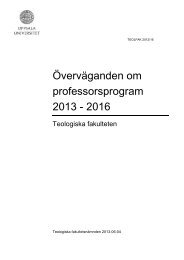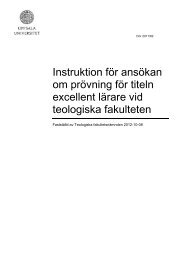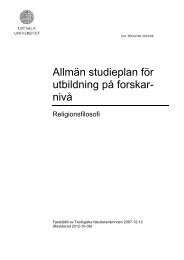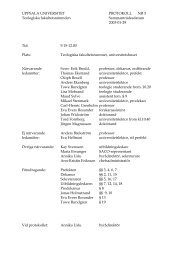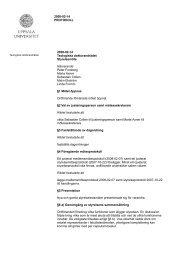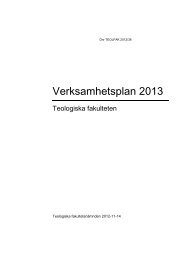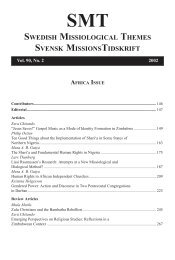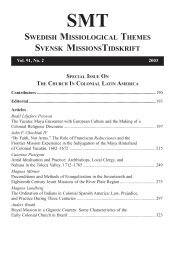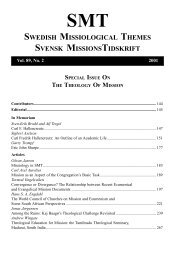SWEDISH MISSIOLOGICAL THEMES SVENSK MISSIONSTIDSKRIFT
SWEDISH MISSIOLOGICAL THEMES SVENSK MISSIONSTIDSKRIFT
SWEDISH MISSIOLOGICAL THEMES SVENSK MISSIONSTIDSKRIFT
You also want an ePaper? Increase the reach of your titles
YUMPU automatically turns print PDFs into web optimized ePapers that Google loves.
496 Tormod Engelsviken<br />
There is no doubt, however, that the voluntarism that emerged in the<br />
nineteenth century was a very important factor both in the formation of<br />
mission societies and in the recruitment of missionaries. The societies did<br />
not always work with the blessing and support of the large folk churches in<br />
Europe that most often also were state churches. The mission societies<br />
were often relatively marginal, but nevertheless able to recruit, send and<br />
support a large number of missionaries without any official church or<br />
government support, politically or financially.<br />
For this was the great age of societies. In many cases the Protestant Churches<br />
as such were unable or unwilling themselves to take up the cause of missions.<br />
This was left to voluntary (sic!) societies, dependent upon the initiative of<br />
consecrated individuals, and relying for financial support on the voluntary<br />
(sic!) gifts of interested Christians. 38<br />
Who have been the missionaries during the last 200 years?<br />
Many of those who have done historical studies of the modern missionary<br />
movement have devoted considerable space to the description of the<br />
missionaries’ national, social, educational and ecclesiastical background.<br />
Sundkler and Steed for instance write about the Protestant mission in Africa<br />
that very few of the men who came as missionaries to Africa had any<br />
experience from the academic or civic world. 39 The majority of the<br />
missionaries in the early part of the century were young men, often in their<br />
twenties. “The Christian movement in nineteenth century Africa was a youth<br />
movement”. 40 These men, if married, brought their wives and children along.<br />
Quite differently from the Catholic missionary force which consisted mostly<br />
of celibate priests, monks and nuns, the Protestant consisted for a large part<br />
of families. These families paid a great toll in terms of deaths on the mission<br />
field throughout the century.<br />
The social background of the missionaries mirrored the social conditions<br />
in Europe at the time. But some missions had certain views or backgrounds<br />
that made them recruit and send out a special type of missionaries. For<br />
example the Moravian missionary recruits had often been weavers,<br />
carpenters and blacksmiths, while the young men in the Hermannsburg<br />
38 Neill 1973:252<br />
39 Sundkler/Steed 2000:109-110<br />
40 Sundkler/Steed 2000:110



